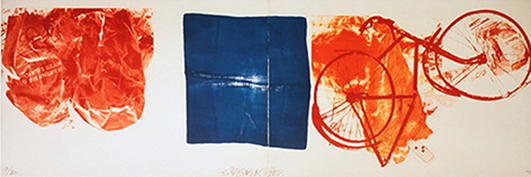Biography

Education
Rauschenberg studied at the Académie Julian in Paris, France. Following his parents' wishes, Rauschenberg attended the University of Texas in Austin to study pharmacology, but was expelled freshman year after refusing to dissect a frog. The draft letter that arrived in 1943 saved him from breaking the news to his parents. Refusing to kill on the battlefield, he was posted to a hospital caring for combat survivors in San Diego. While on leave, he saw oil paintings in person for the first time at the East Huntington Library. After the war ended, Rauschenberg drifted, eventually using the G.I. Bill to pay for art classes at Kansas City Art Institute in 1947, and a year later, at the Académie Julian in Paris. In the late 1940's he attended Black Mountain College in North Carolina much like many other artists we have gone over in class. All I can say is thank goodness for all those bizarre events or we wouldn't have had him as an artist. From 1949 to 1952 Rauschenberg studied with Vaclav Vytlacil and Morris Kantor at the Art Students League of New York.

Life & Carrer
Rauschenberg was born as Milton Ernest Rauschenberg in Port Arthur, Texas, the son of Dora Carolina (née Matson) and Ernest R. Rauschenberg. His father was of German and Cherokee ancestry and his mother of Anglo-Saxon descent. His parents were Fundamentalist Christians. Rauschenberg studied at the Kansas City Art Institute and the Académie Julian in Paris, France, where he met the painter Susan Weil. In 1948 Rauschenberg and Weil decided to attend Black Mountain College in North Carolina
Josef Albers, a founder of the Bauhaus, became Rauschenberg's painting instructor at Black Mountain. Albers' preliminary courses relied on strict discipline that did not allow for any "uninfluenced experimentation". Rauschenberg described Albers as influencing him to do "exactly the reverse" of what he was being taught.
From 1949 to 1952 Rauschenberg studied with Vaclav Vytlacil and Morris Kantor at the Art Students League of New York, where he met fellow artists Knox Martin and Cy Twombly.
Rauschenberg married Susan Weil in 1950. Their only child, Christopher, was born July 16, 1951. They divorced in 1953. According to a 1987 oral history by the composer Morton Feldman, after the end of his marriage, Rauschenberg had romantic relationships with fellow artists Cy Twombly and Jasper Johns. An article by Jonathan D. Katz states that Rauschenberg's affair with Twombly began during his marriage to Susan Weil.

Legacy
Already in 1984, Rauschenberg announced his Rauschenberg Overseas Culture Interchange (ROCI) at the United Nations. This would culminate in a seven-year, ten-country tour to encourage "world peace and understanding", through Mexico, Chile, Venezuela, Beijing, Lhasa (Tibet), Japan, Cuba, Soviet Union, Berlin, and Malaysia in which he left a piece of art, and was influenced by the cultures he visited. Paintings, often on reflective surfaces, as well as drawings, photographs, assemblages and other multimedia were produced, inspired by these surroundings, and this was considered some of his strongest works.
The ROCI venture, supported by the National Gallery of Art in Washington, D.C., went on view in 1991.In 1990, Rauschenberg created the Robert Rauschenberg Foundation (RFF) to promote awareness of the causes he cared about, such as world peace, the environment and humanitarian issues. He also set up Change, Inc., to award one-time grants of up to $1,000 to visual artists based on financial need. Rauschenberg's will, filed in Probate Court on October 9, 2008, named his charitable foundation as a major beneficiary, along with Darryl Pottorf, Christopher Rauschenberg, Begneaud, his nephew Byron Richard Begneaud, and Susan Weil Kirschenbaum. The amounts to be given to the beneficiaries were not named, but the estate is "worth millions", said Pottorf, who is also executor of the estate.The RRF today owns many works by Rauschenberg from every period of his career. In 2011, the foundation, in collaboration with Gagosian Gallery, presented "The Private Collection of Robert Rauschenberg", selections from Rauschenberg's personal art collection; proceeds from the collection helped fund the endowment established for the foundation's philanthropic activities. Also in 2011, the foundation launched its "Artist as Activist" print project and invited Shepard Fairey to focus on an issue of his choice. The editioned work he made was sold to raise funds for the Coalition for the Homeless. The RRF artist residency takes place at the late artist's property in Captiva Island, Florida. The foundation also maintains the 19th Street Project Space in New York.

Exhibitions
1951 First one-man show at the Betty Parsons Gallery.
1954 Second one-man show at the Charles Egan Gallery.
1955 at the Charles Egan Gallery.
1955 Bed, one of his first and certainly most famous Combines.
1963 first retrospective, Jewish Museum, New York.
1964 first American artist to win the Grand Prize at the Venice Biennale.
1976 A retrospective at the Smithsonian American Art Museum), Washington, D.C.
1978 A retrospective at the Solomon R. Guggenheim Museum, New York.
1997-99 Houston, Cologne and Bilbao.
2005 at the Metropolitan Museum of Art, New York.
2007 Museum of Contemporary Art, Los Angeles, Centre Georges Pompidou, Paris, and Moderna Museet, Stockholm, through 2007), and at the Peggy Guggenheim Collection, Venice.
2009–10 the Tinguely Museum, Basel, Guggenheim Museum Bilbao, and Villa e Collezione Panza, Varese.
2008 A memorial exhibition of photographs opened October 22, (on his 83rd birthday) at the Guggenheim Museum.
